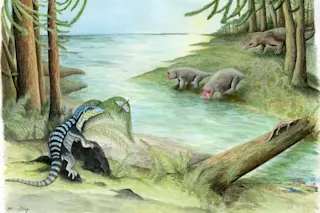A dinosaur relative about the size of an iguana, which lived at the bottom of the world 250 million years ago, is throwing paleontologists for a loop. Antarctanax shackletoni, named for explorer Ernest Shackleton, hints at unexpected biodiversity on the now-frozen continent of Antarctica.
About 252 million years ago, the greatest mass extinction known walloped life on Earth. An estimated 90 percent of all living things perished. In the wake of this event, known as the end-Permian or Great Dying, surviving species diversified to occupy all those newly vacant ecological niches.
Early archosaurs were among the animals that fared well following the mass extinction: The group quickly expanded into crocodilians, pterosaurs and, most famously, dinosaurs. Paleontologists have been piecing together the story of how rapidly archosaurs evolved and spread across the planet — that’s where Antarctanax comes in.
Discovered during a dig in Antarctica’s interior, Antarctanax dates to the earliest ...














